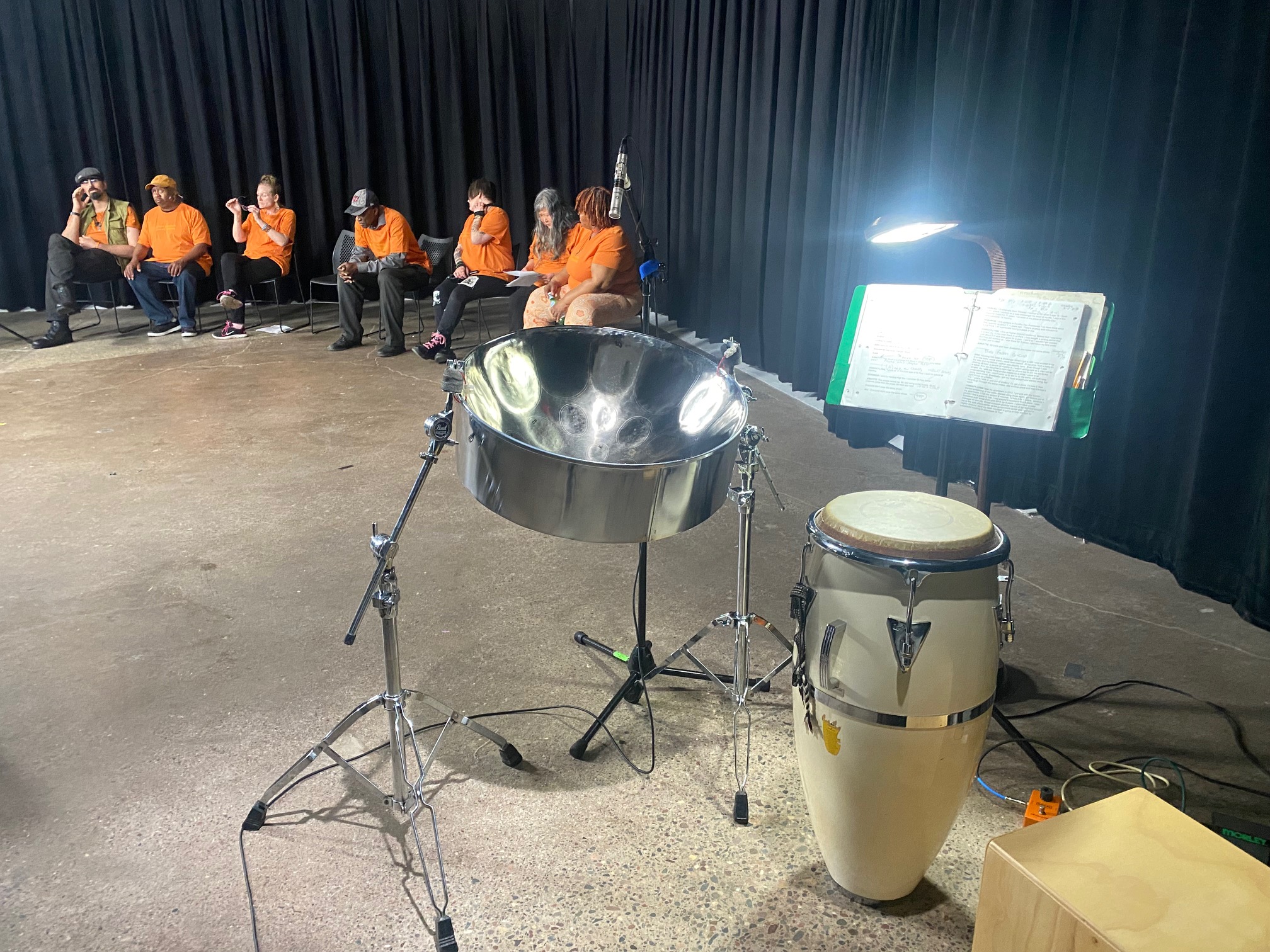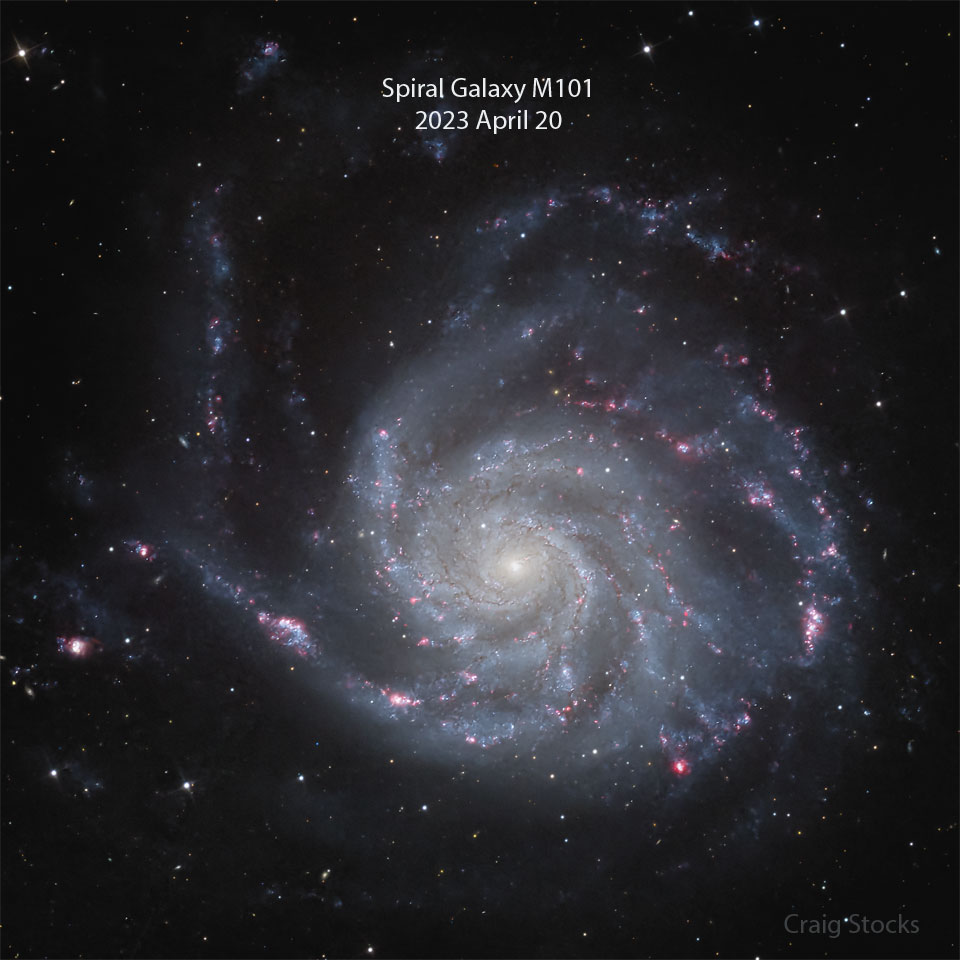Teaching a Rhythm Roots Workshop Residency at Cerenity Humboldt Senior Care center in St Paul. (https://cerenityseniorcare.org/cerenity-senior-care-humboldt-st-paul-mn/). 6th in a series of 9 workshops exploring cultural rhythms from an array of world traditions.

Zamya Theater performs Challenge to Change today Wednesday May 24th 9am at the Dorthy Day Center of Catholic Charities in St Paul. Music provided by mick laBriola.

A nearby star has exploded and humanity’s telescopes are turning to monitor it. The supernova, dubbed SN 2023ixf, was discovered by Japanese astronomer Koichi Itagaki three days ago and subsequently located on automated images from the Zwicky Transient Facility two days earlier. SN 2023ixf occurred in the photogenic Pinwheel Galaxy M101, which, being only about 21 million light years away, makes it the closest supernova seen in the past five years, the second closest in the past 10 years, and the second supernova found in M101 in the past 15 years. Rapid follow up observations already indicate that SN 2023ixf is a Type II supernova, an explosion that occurs after a massive star runs out of nuclear fuel and collapses. The featured image shows home spiral galaxy two days ago with the supernova highlighted, while the roll-over image shows the same galaxy a month before. SN 2023ixf will likely brighten and remain visible to telescopes for months. Studying such a close and young Type II supernova may yield new clues about massive stars and how they explode.

see full post...
Max Bennett (May 24, 1928 – September 14, 2018) was an American jazz bassist and session musician. Bennett grew up in Kansas City, Missouri and Oskaloosa, Iowa, and went to college in Iowa.
His first professional gig was with Herbie Fields in 1949, and following this he played with Georgie Auld, Terry Gibbs, and Charlie Ventura. He served in the Army during the Korean War from 1951 to 1953, and then played with Stan Kenton before moving to Los Angeles. There he played regularly at the Lighthouse Cafe with his own ensemble, and played behind such vocalists as Peggy Lee, Ella Fitzgerald, Joni Mitchell and Joan Baez through the 1970s. He also recorded with Charlie Mariano, Conte Candoli, Bob Cooper, Bill Holman, Stan Levey, Lou Levy, Coleman Hawkins and Jack Montrose.
Bennett recorded under his own name from the late 1950s and did extensive work as a composer and studio musician in addition to jazz playing. Often associated with The Wrecking Crew, he performed on many records by The Monkees and The Partridge Family.
see full post...Bob Dylan (legally Robert Dylan, born Robert Allen Zimmerman, May 24, 1941) is an American singer-songwriter. Often regarded as one of the greatest songwriters of all time, Dylan has been a major figure in popular culture during a career spanning more than 60 years. Much of his most celebrated work dates from the 1960s, when songs such as “Blowin’ in the Wind” (1963) and “The Times They Are a-Changin’“(1964) became anthems for the civil rights and antiwar movements. His lyrics during this period incorporated a range of political, social, philosophical, and literary influences, defying pop music conventions and appealing to the burgeoning counterculture.
Dylan was born and raised in St. Louis County, Minnesota. Following his self-titled debut album in 1962, which comprised mainly traditional folk songs, he made his breakthrough as a songwriter with the release of The Freewheelin’ Bob Dylan the following year. The album features “Blowin’ in the Wind” and the thematically complex “A Hard Rain’s a-Gonna Fall“. Many of his songs adapted the tunes and phraseology of older folk songs. He went on to release the politically charged The Times They Are a-Changin’ and the more lyrically abstract and introspective Another Side of Bob Dylan in 1964. In 1965 and 1966, Dylan drew controversyamong folk purists when he adopted electrically amplified rock instrumentation, and in the space of 15 months recorded three of the most important and influential rock albums of the 1960s: Bringing It All Back Home, Highway 61 Revisited (both 1965) and Blonde on Blonde (1966). His six-minute single “Like a Rolling Stone” (1965) expanded commercial and creative boundaries in popular music.
In July 1966, a motorcycle accident led to Dylan’s withdrawal from touring. During this period, he recorded a large body of songs with members of the Band, who had previously backed him on tour. These recordings were released as the collaborative album The Basement Tapes in 1975. In the late 1960s and early 1970s, Dylan explored country music and rural themes in John Wesley Harding (1967), Nashville Skyline (1969), and New Morning (1970). In 1975, he released Blood on the Tracks, which many saw as a return to form. In the late 1970s, he became a born-again Christian and released a series of albums of contemporary gospel music before returning to his more familiar rock-based idiom in the early 1980s. Dylan’s 1997 album Time Out of Mind marked the beginning of a renaissance for his career. He has released five critically acclaimed albums of original material since then, the most recent being Rough and Rowdy Ways (2020). He also recorded a series of three albums in the 2010s comprising versions of traditional American standards, especially songs recorded by Frank Sinatra. Dylan has toured continuously since the late 1980s on what has become known as the Never Ending Tour.
Since 1994, Dylan has published nine books of paintings and drawings, and his work has been exhibited in major art galleries. He has sold more than 145 million records, making him one of the best-selling musicians of all time. He has received numerous awards, including the Presidential Medal of Freedom, ten Grammy Awards, a Golden Globe Award and an Academy Award. Dylan has been inducted into the Rock and Roll Hall of Fame, Nashville Songwriters Hall of Fame and the Songwriters Hall of Fame. The Pulitzer Prize Board in 2008 awarded him a special citation for “his profound impact on popular music and American culture, marked by lyrical compositions of extraordinary poetic power”. In 2016, Dylan was awarded the Nobel Prize in Literature “for having created new poetic expressions within the great American song tradition”.
see full post...Archie Shepp (born May 24, 1937) is an American jazz saxophonist, educator and playwright who since the 1960s has played a central part in the development of avant-garde jazz.
Shepp was born in Fort Lauderdale, Florida, but raised in Philadelphia, Pennsylvania. He studied piano, clarinet and alto saxophone before narrowing his focus to tenor saxophone. He occasionally plays soprano saxophone as well. He studied drama at Goddard College from 1955 to 1959.
He played in a Latin jazz band for a short time before joining the band of avant-garde pianist Cecil Taylor. Shepp’s first recording under his own name, Archie Shepp – Bill Dixon Quartet, was released on Savoy Records in 1962 and featured a composition by Ornette Coleman. In 1962, he performed with Dixon at the 8th World Festival of Youth and Students in Helsinki, Finland. Along with alto saxophonist John Tchicai and trumpeter Don Cherry, he formed the New York Contemporary Five. John Coltrane‘s admiration for Shepp led to recordings for Impulse! Records, the first of which was Four for Trane in 1964, an album of mainly Coltrane compositions on which he was joined by Tchicai, trombonist Roswell Rudd, trumpeter Alan Shorter, bassist Reggie Workman and drummer Charles Moffett.
see full post...Here is a close-up view of a region of NGC 1499. If the shape of this cosmic cloud seen as a whole in many beautiful pictures evokes California, then we are here in the Sierra Nevada mountains! The shapes carved in the gas and dust clouds and the impression of relief reinforce this comparison with the famous American region and I found it interesting to frame this part of the nebula where the ionized gas erodes and spreads out into space.
The amount of signal and detail on the S and H layers is quite impressive, while the O layer is weak and diffuse but sufficient to offer the possibilities of a nice mix. Of course and as usual, the SHO rendering leaves room for color mapping and interpretation which make the processing very funny with interesting artistic possibilities, while respecting the distribution of the components of this beautiful object.

Nathaniel Adderley Jr. (born May 23, 1955) is an American pop and rhythm and blues music arranger and pianist who spent much of his music career arranging as music director for Luther Vandross tours and contributed as co-songwriter on most of Vandross’s albums. His father Nat Adderley (1931–2000) was a composer and jazz cornet and trumpet player, while his uncle Cannonball Adderley (1928–1975) was a jazz alto saxophonist.
Nat Adderley Jr. was born in Quincy, Florida, on May 23, 1955. The scion of a famed jazz family, he grew up in Teaneck, New Jersey, moving to that suburban New York City community with his family when he was five years old. He started playing piano as a child and had his first song, “I’m on My Way”, recorded by his uncle Cannonball on the 1967 album Why Am I Treated So Bad! by the Cannonball Adderley Quintet when the young Nat Adderley was only 11 years old. While at the Fiorello H. LaGuardia High School of Music & Art and Performing Arts in New York City, Adderley first met Luther Vandross, who attended Taft High School in the Bronx. Adderley would end up spending much of his musical career with Vandross. He attended Yale University, graduating with a degree in African American studies.
see full post...Donald Moye, Jr. (born May 23, 1946), known as Famoudou Don Moye, is an American jazzpercussionist and drummer. He is most known for his involvement with the Art Ensemble of Chicago and is noted for his mastery of African and Caribbean percussion instruments and rhythmic techniques.
Moye was born in Rochester, New York, United States, and performed in various drum and bugle corps(including the Rochester Crusaders) during his youth, as well as church choir. Moye has commented that he really “didn’t have an affinity for the bugle… and just kind of gravitated towards drums.” He also took violin lessons during this time. Moye was exposed to jazz at an early age since his mother worked for a local social club, that had a jazz club next door, which hosted musicians such as Kenny Burrell and Jimmy McGriff. His family was also musically inclined; his uncles played saxophones and his father played drums. Also, his mother used to take him to various performances as a child, such as “opera under the stars” and to see Mahalia Jackson.
see full post...Robert Arthur Moog (/moʊɡ/ MOHG; May 23, 1934 – August 21, 2005 NY, NY) was an American engineer and electronic music pioneer. He was the founder of the synthesizer manufacturer Moog Music and the inventor of the first commercial synthesizer, the Moog synthesizer, which debuted in 1964. In 1970, Moog released a more portable model, the Minimoog, described as the most famous and influential synthesizer in history. Among Moog’s honors are a Technical Grammy Award, received in 2002, and an induction into the National Inventors Hall of Fame.
By 1963, Moog had been designing and selling theremins for several years while working toward a PhD in engineering physics at Cornell University. He developed his synthesizer in response to demand for more practical and affordable electronic-music equipment, guided by suggestions and requests from composers. Moog’s principal innovation was the voltage-controlled oscillator, which uses voltage to control pitch. He also introduced fundamental synthesizer concepts such as modularity, envelope generation and the pitch wheel. He is credited with introducing synthesizers to a wider audience and influencing the development of popular music.
Moog pursued his work as a hobby, and he is regarded as a poor businessman. His only patent was on his filter design; commentators have speculated that he would have become extremely wealthy had he patented his other innovations, but that their availability in the public domain helped the synthesizer industry flourish.
In 1971, Moog sold Moog Music to Norlin Musical Instruments, where he remained as a designer until 1977. In 1978, he founded the company Big Briar, and in 2002 he renamed it Moog Music after reacquiring the rights to the name. In later years, Moog taught at the University of North Carolina at Asheville and worked on designs for further instruments. He died at the age of 71 from a brain tumor.
see full post...The jellyfish galaxy JW39 hangs serenely in this image from the NASA/ESA Hubble Space Telescope. This galaxy lies over 900 million light-years away in the constellation Coma Berenices, and is one of several jellyfish galaxies that Hubble has been studying over the past two years.
Despite this jellyfish galaxy’s serene appearance, it is adrift in a ferociously hostile environment; a galaxy cluster. Compared to their more isolated counterparts, the galaxies in galaxy clusters are often distorted by the gravitational pull of larger neighbours, which can twist galaxies into a variety of weird and wonderful shapes. If that was not enough, the space between galaxies in a cluster is also pervaded with a searingly hot plasma known as the intracluster medium. While this plasma is extremely tenuous, galaxies moving through it experience it almost like swimmers fighting against a current, and this interaction can strip galaxies of their star-forming gas.
This interaction between the intracluster medium and the galaxies is called ram-pressure stripping, and is the process responsible for the trailing tendrils of this jellyfish galaxy. As JW39 has moved through the cluster the pressure of the intracluster medium has stripped away gas and dust into long trailing ribbons of star formation that now stretch away from the disc of the galaxy.
Astronomers using Hubble’s Wide Field Camera 3 studied these trailing tendrils in detail, as they are a particularly extreme environment for star formation. Surprisingly, they found that star formation in the ‘tentacles’ of jellyfish galaxies was not noticeably different from star formation in the galaxy disc.
[Image Description: A spiral galaxy. It is large in the centre with a lot of detail visible. The core glows brightly and is surrounded by concentric rings of dark and light dust. The spiral arms are thick and puffy with grey dust and glowing blue areas of star formation. They wrap around the galaxy to form a ring. Part of the arm is drawn out into a dark thread above the galaxy, and dust from the arm trails off to the right.]

Elek Bacsik (22 May 1926 – 14 February 1993) was a Hungarian-American jazz guitarist and violinist. He was the cousin of guitarist Django Reinhardt.
Bacsik was born in Budapest, Hungary. He was the son of Árpád Bacsik and Erzsébet Pócsi. He studied classical violin at the Budapest Conservatory before moving to jazz guitar. He worked in a big band with Jozsef Quitter and Geza Szabo and recorded for the first time in his career with this band in 1943. A few years later he went on tour in Europe and Lebanon with Mihaly Tabanyi. He was hired by Renato Carosone to be in a quartet with Peter Van Wood and Gegè Di Giacomo in which he played bass, violin, and guitar. When he lived in Paris, he accompanied American musicians who were passing through, such as Lou Bennett, Dizzy Gillespie, Quentin Jackson, Art Simmons, and Clark Terry.
see full post...Le Sony’r Ra (born Herman Poole Blount, May 22, 1914 – May 30, 1993), better known as Sun Ra, was an American jazz composer, bandleader, piano and synthesizer player, and poet known for his experimental music, “cosmic” philosophy, prolific output, and theatrical performances. For much of his career, Ra led “The Arkestra”, an ensemble with an ever-changing name and flexible line-up.
Born and raised in Alabama, Blount became involved in the Chicago jazz scene during the late 1940s. He soon abandoned his birth name, taking the name Le Sony’r Ra, shortened to Sun Ra (after Ra, the Egyptian god of the Sun). Claiming to be an alien from Saturn on a mission to preach peace, he developed a mythical persona and an idiosyncratic credo that made him a pioneer of Afrofuturism. Throughout his life he denied ties to his prior identity saying, “Any name that I use other than Ra is a pseudonym.” His widely eclectic and avant-garde music echoed the entire history of jazz, from ragtime and early New Orleans hot jazz, to swing music, bebop, free jazz and fusion. His compositions ranged from keyboard solos to works for big bands of over 30 musicians, along with electronic excursions, songs, chants, percussion pieces, and anthems.
From the mid-1950s until his death, Ra led the musical collective The Arkestra (which featured artists such as Marshall Allen, John Gilmore and June Tyson throughout its various iterations). Its performances often included dancers and musicians dressed in elaborate, futuristic costumes inspired by ancient Egyptian attire and the Space Age. Following Ra’s illness-forced retirement in 1992, the band remained active as The Sun Ra Arkestra, and, as of 2022, continues performing under the leadership of veteran Ra sideman Marshall Allen.
Though his mainstream success was limited, Sun Ra was a prolific recording artist and frequent live performer, and remained influential throughout his life for his music and persona. He is now widely considered an innovator; among his distinctions are his pioneering work in free improvisation and modal jazzand his early use of electronic keyboards and synthesizers. Over the course of his career, he recorded dozens of singles and over one hundred full-length albums, comprising well over 1,000 songs, making him one of the most prolific recording artists of the 20th century.
He was born Herman Blount on May 22, 1914, in Birmingham, Alabama, as discovered by his biographer, John F. Szwed, and published in his 1998 book, Space Is the Place: The Lives and Times of Sun Ra. He was named after the popular vaudeville stage magician Black Herman, who had deeply impressed his mother. He was nicknamed “Sonny” from his childhood, had an older sister and half-brother, and was doted upon by his mother and grandmother.
see full post...